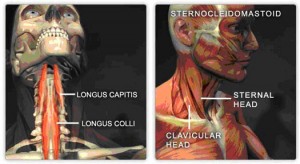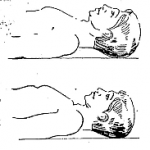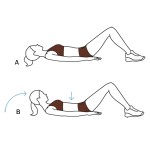Neck Pain and Deep Neck Flexor Exercises, Range of Motion Physical Therapy Clinic Dublin
I see a lot of clients suffering from acute or chronic neck pain. Some of the incidents of acute neck pain are caused by whiplash injuries and more subtle injuries such as lifting objects incorrectly or jarring neck muscles.
Clients who suffer a whiplash injury and do not seek treatment can suffer from Chronic Neck Pain later in life, due to weakness and imbalance of the neck muscles.
Chronic neck pain can also be caused by poor posture, a number of clients suffer from Forward Head Posture (FHP) and Rounded Shoulders. Forward head posture is as a result of the deep neck flexor muscles at the front of your neck becoming tight, while the posterior cervical muscles at the back of the neck are shorten and weakened, causing the head to be pulled forward. Typically this posture is accompanied by rounded shoulders, placing further pull and tightness on the shoulders and upper back (Upper Cross Syndrome).
 When treating this type of neck pain it is important to focus on the deep Neck Painneck flexor muscles (DNF); include the longus capitus and colli, while also looking to release the sternocleidomastoid with the posterior cervical muscles.
When treating this type of neck pain it is important to focus on the deep Neck Painneck flexor muscles (DNF); include the longus capitus and colli, while also looking to release the sternocleidomastoid with the posterior cervical muscles.
In order to ensure muscle balance between the anterior and posterior aspect of the neck it is important to have sufficient motor control of the two groups of muscles.
These two exercises have been identified as the best early stage exercises to help recruit and strengthen the DNF while also helping to lengthen the posterior cervicals.
 Exercise 1: Chin TuckChin Tuck for Neck Pain
Exercise 1: Chin TuckChin Tuck for Neck Pain
This exercises is best started lying down with your knees bent up.
In order to complete the exercise simply draw your chin down towards the floor, causing a slight nod of the head.
Hold for 5 – 10 secs and repeat 5 – 10 times, twice a day.
 Exercise 2: Head liftNeck Exercise
Exercise 2: Head liftNeck Exercise
This exercise is a slight progression from the chin tuck.
In the same starting position, simply lift your head of the floor 3-4″
Hold for a couple of seconds and repeat 10 times
Both these exercise help build strength and endurance and enable you to switch on and gain control of the muscle groups. These exercises would also be accompanied by some shoulder exercises, such as scapula pinches to assist with the stabilisation of the neck.
These exercises should be performed pain free, if they cause any pain stop the exercise and contact a Range of Motion Physical Therapy Lucan Dublin for further assistance.

